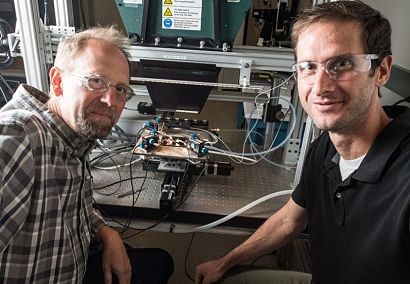
The six-junction solar cell now holds the world record for the highest solar conversion efficiency at 47.1 percent, which was measured under concentrated illumination. A variation of the same cell also set the efficiency record under one-sun illumination at 39.2 percent.
“This device really demonstrates the extraordinary potential of multijunction solar cells” said John Geisz, a principal scientist in the High-Efficiency Crystalline Photovoltaics Group at NREL and lead author of a new paper on the record-setting cell.
The paper, “Six-junction III-V solar cells with 47.1 percent conversion efficiency under 143 suns concentration”, appears in the journal Nature Energy. Geisz’s co-authors are NREL scientists Ryan France, Kevin Schulte, Myles Steiner, Andrew Norman, Harvey Guthrey, Matthew Young, Tao Song, and Thomas Moriarty.
To construct the device, NREL researchers relied on III-V materials - so called because of their position on the periodic table - that have a wide range of light absorption properties. Each of the cell’s six junctions (the photoactive layers) is specially designed to capture light from a specific part of the solar spectrum. The device contains about 140 total layers of various III-V materials to support the performance of these junctions, and yet is three times narrower than a human hair. Due to their highly efficient nature and the cost associated with making them, III-V solar cells are most often used to power satellites, which prize III-V’s unmatched performance.
On Earth, however, the six-junction solar cell is well-suited for use in concentrator photovoltaics, added Ryan France, co-author and a scientist in the III-V Multijunctions Group at NREL.
“One way to reduce cost is to reduce the required area” he said, “and you can do that by using a mirror to capture the light and focus the light down to a point. Then you can get away with a hundredth or even a thousandth of the material, compared to a flat-plate silicon cell. You use a lot less semiconductor material by concentrating the light. An additional advantage is that the efficiency goes up as you concentrate the light.”
France described the potential for the solar cell to exceed 50 percent efficiency as “actually very achievable” but that 100 percent efficiency cannot be reached due to the fundamental limits imposed by thermodynamics.
Geisz said that currently the main research hurdle to topping 50 percent efficiency is to reduce the resistive barriers inside the cell that impede the flow of current. Meanwhile, he notes that NREL is also heavily engaged in reducing the cost of III-V solar cells, enabling new markets for these highly efficient devices. The US Department of Energy Solar Energy Technologies Office funded the research.
NREL is the US Department of Energy's primary national laboratory for renewable energy and energy efficiency research and development. NREL is operated for the Energy Department by The Alliance for Sustainable Energy, LLC.
Image: Scientists John Geisz (left) and Ryan France fabricated a solar cell that is nearly 50% efficient. Photo by Dennis Schroeder, NREL
For additional information:

